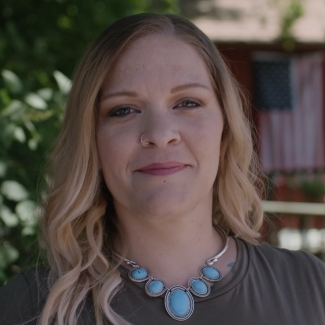
GATEWAY: Jen Wysong Tells Recovery Story in New Documentary
Lights, camera, action!
Shatterproof Ambassador Jen Wysong recently had the opportunity to share her personal story of addiction and recovery in a new documentary titled GATEWAY. It’s a film about three everyday families impacted by an opioid addiction that was sparked by a prescription to manage pain after surgery. The documentary provides an intimate look into the struggles that can be caused by opioid prescriptions when the dangers of these medications are not properly understood.
We recently spoke with Jen about her road to recovery and what it was like to be part of the film.
Your addiction stemmed from an opioid prescription you received after your C-section delivery. Can you tell us more about your story?
The day I delivered my daughter was chaotic. I was only 20 years old and my doctor was telling me I had no other option than to deliver via C-section. At the time, I had no concerns being prescribed opioids following my C-section because I didn’t realize how dangerous these medications can be. To be honest, I wasn’t given any other option, so I took the opioids to manage the pain. Looking back, I had no knowledge of the risks of opioids and didn’t understand how a prescription could lead me down the dark path of addiction I ultimately faced.
Like many others, it sounds like your journey was filled with many ups and downs. How did you get to the where you are today?
At first, opioids made me feel like I could take on the world. The doctor advised me to take the entire script, and at first, I felt like I was a better mother when I was taking the opioids than when I wasn’t taking them. Before I knew it, my dependence following surgery quickly spiraled into addiction and I continued to take opioids for years. Ultimately the pills became harder and more expensive to get, so I resorted to heroin and put myself in countless harmful situations.
Opioids took over my life and I couldn’t take care of my daughter anymore. I tried multiple stints in rehab that were unsuccessful and even ended up in jail. My addiction had reached its worst. During my last time in jail, my daughter was being cared for by my mother and celebrating her birthday. I realized what I was missing and what it would be like if I were gone. I knew I needed to find recovery and be there for my daughter. I was tired of hating myself and doing the things my disease led me to. I was ready to do anything it took to find recovery.
Earlier this year I celebrated three years in recovery. Today, my relationship with my daughter and family is better than ever. I am so grateful to have found long-term sobriety and continue to work hard each and every day to honor my life without opioids or any other harmful substances.
You now work as a peer support counselor. How does it feel to help other women who struggle with addiction?
I work at Recovery in Motion in Chestertown, Maryland, the same facility that helped me achieve long-term sobriety. This work has given me so much purpose in my life. It is a blessing every single day to wake up and help others who are going through what I once experienced. Every day that I walk through the doors of Recovery in Motion, I set out to help and get through to someone who is in the same place I once was.
Through working on this film, I’ve learned that there’s research showing that women are 40% more likely than men to become long-term users of opioids after surgery. That’s why I started educating others and advocating for the use of non-opioid options to manage pain after surgery. Options like these are especially important for people in recovery who may need surgery but are afraid they may be exposed to opioids. These alternatives can help eliminate exposure to opioids while effectively controlling pain without the risks of dependence and addiction after surgery.
Can you tell us about GATEWAY? How did you end up being a part of the film?
GATEWAY tells the stories of three families from different parts of the country who have all been impacted in some way by opioid addiction after surgery. Ultimately, the film hopes to shine a light on the potential dangers of opioids after surgery and the availability of non-opioid options that can help reduce or eliminate the need for opioids altogether.
As a Shatterproof Ambassador, I am active in the recovery community and always willing to share my story in hopes of helping others. When I received the call asking if I would be interested in being a part of this documentary, I couldn’t say “yes” fast enough! I believe that we need to talk about addiction in an effort to the reduce the stigma associated with this disease. If I can help one person who may be struggling, then it’s all worth it.
What was the filming process like?
It was an incredibly emotional experience for me, but also really awesome! The crew came out to Chestertown for a few days and filmed at my house, Recovery and Motion, and various other locations around town. Being a peer-support counselor, and working on my own recovery every day, I’m comfortable sharing details about my addiction and road to sobriety. But filming for GATEWAY took that to a whole new level as my family and loved ones shared how they were impacted by my addiction as well. It was heart wrenching at times, like hearing my mother explain what she went through when I was at my worst. But ultimately, I am so thankful to have had the opportunity to share my story with the public and be a part of this film. GATEWAY delivers a raw and honest look at opioid addiction from so many different angles.
What differentiates GATEWAY from other opioid documentaries?
GATEWAY focuses on an often-overlooked contributor to the nation’s opioid epidemic – the surgical setting. There are of course safe and effective uses for prescription opioids, but there are also alternatives available, especially to surgical patients. And why risk dependence, addiction, and other issues if we can avoid it? We should be making every effort to spare other families the type of pain my family went through. The film helps raise awareness about the safe and effective non-opioid options available that can reduce or eliminate the need for opioids and their associated risks. While making this film, I learned so many startling facts about opioid overprescribing. It is unacceptable to me that despite national efforts to end the opioid epidemic, patients continue to receive large quantities of opioids to manage pain after surgery. Bringing this topic to the forefront is extremely important in the fight to help prevent people from becoming addicted to opioids in the first place.
Where can readers learn more about GATEWAY?
People can watch the full documentary at GatewayFilm.com. The website also features a Public Service Announcement (PSA), photos from the film, three shorter films on each of our stories, and a social media toolkit to help spread the word. I urge everyone to watch GATEWAY and help spread the message that there are non-opioid options available that can reduce, or completely eliminate, the need for opioids after surgery.




